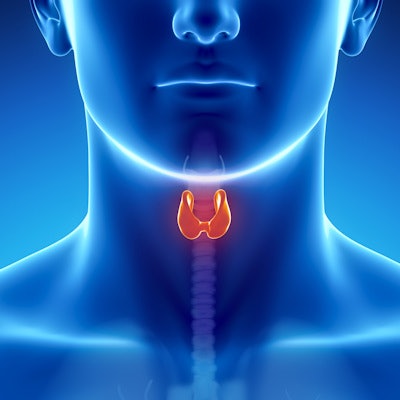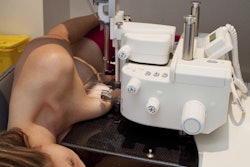
A new risk stratification model for thyroid nodules has been published by the American College of Radiology (ACR) Thyroid Imaging Reporting and Data System (TI-RADS) committee. The TI-RADS model is designed to be easy to use by ultrasound practitioners and reduce the number of unnecessary biopsies for thyroid nodules.
 Dr. Franklin Tessler, ACR TI-RADS committee chair.
Dr. Franklin Tessler, ACR TI-RADS committee chair.
"The effort was primarily prompted by our impression that existing risk stratification systems are challenging to apply, as well as our desire to see if we could consider higher size thresholds for recommending FNA for nodules that are not highly suspicious," Tessler told AuntMinnie.com. "Our approach also aligns with the trend toward observation ('watchful waiting') for small nodules that are highly suspicious."
The committee shared its recommendations in a white paper published online in the Journal of the American College of Radiology on March 31.
Limited adoption
Groups of researchers and societies such as the American Thyroid Association (ATA) and the Society of Radiologists in Ultrasound (SRU) have proposed their own methods for guiding ultrasound practitioners in recommending biopsies of thyroid nodules based on ultrasound features. However, adoption of these approaches in the ultrasound community has been limited due to their complexity and lack of congruence, according to the authors.
The ACR TI-RADS committee formulated its own risk stratification system, following up on ACR white papers published in 2014 that presented an approach for managing incidental thyroid nodules and proposed a lexicon for ultrasound reporting of these nodules. The new system is designed to identify most clinically significant malignancies while decreasing the number of biopsies performed on benign nodules.
In developing ACR TI-RADS, the committee agreed that the system would be founded on the ultrasound features defined in its previously published ultrasound reporting lexicon and that it needed to be easy to apply across a wide gamut of ultrasound practice. It also had to be able to classify all thyroid nodules and be based to the greatest extent possible on evidence, according to the authors.
The resulting method classifies nodules based on ultrasound features related to composition, echogenicity, shape, margin, and echogenic foci; points are given for all features, with additional points awarded for more suspicious features. The point total determines the nodule's TI-RADS level:
- TR1: Benign - 0 points
- TR2: Not suspicious for malignancy - 2 points
- TR3: Mildly suspicious for malignancy - 3 points
- TR4: Moderately suspicious for malignancy - 4 to 6 points
- TR5: Highly suspicious for malignancy - 7 points or more
No nodule left behind
In contrast to other recommendations, TI-RADS does not rely on practitioners figuring out which pattern of ultrasound features most closely fits the nodule.
"This means that all nodules can be classified, which is not the case with some other guidelines," Tessler said. "Our motto was no nodule left behind."
In addition, the system lacks subcategories and is straightforward to apply across a wide range of ultrasound practices, he said.
"We wanted to make it as simple as possible," he said.
The committee did not incorporate ultrasound elastography into TI-RADS due to concerns that the promising technique is probably not available in many ultrasound laboratories.
Follow-up recommendations are determined by the nodule's TI-RADS level and maximum diameter.
| TI-RADS follow-up recommendations | |
| Category | Follow-up recommendations |
| TR1: Benign | No FNA biopsy |
| TR2: Not suspicious for malignancy | No FNA biopsy |
| TR3: Mildly suspicious for malignancy | FNA biopsy if nodule ≥ 2.5 cm; follow if ≥ 1.5 cm |
| TR4: Moderately suspicious for malignancy | FNA biopsy if nodule ≥ 1.5 cm; follow if ≥ 1 cm |
| TR5: Highly suspicious for malignancy | FNA biopsy if nodule ≥ 1 cm; follow if ≥ 0.5 cm |
"We also defined lower size limits for recommending follow-up ultrasound for TR3, TR4, and TR5 nodules to limit the number of repeat sonograms for those that are likely to be benign or not clinically significant," the authors wrote.
In addition, the committee advocated a higher size threshold for deciding whether or not to perform FNA biopsy of mildly and moderately suspicious nodules.
"This was based on our observation that current recommendations from some other groups were based on nodule size at pathology, not ultrasound," Tessler said. "Sonographic dimensions tend to be higher, so we took this into account."
The committee also recommended timing follow-up sonograms based on the nodule's ACR TI-RADS level; the higher the level, the more often scans should be performed:
- TR3: Follow-up sonograms may be performed at 1, 3, and 5 years
- TR4: Follow-up scans should be performed at 1, 2, 3, and 5 years
- TR5: Follow-up scans are recommended every year for 5 years
"Imaging can stop at five years if there is no change in size, as stability over that time span reliably indicates that a nodule has a benign behavior," the authors wrote.
Although there isn't any published evidence to guide management of nodules that enlarge significantly but remain below the FNA size threshold for their ACR TI-RADS level at five years, continued follow-up is probably warranted, according to the group. If the nodule's ACR TI-RADS level increases on follow-up, the next sonogram should still be performed in one year, regardless of its initial level, they wrote.
Based on evidence
The committee developed ACR TI-RADS based on a literature review, a new analysis of the U.S. National Cancer Institute's Surveillance, Epidemiology, and End Results (SEER) data, evaluation of existing risk classification systems, and expert opinion. Tessler noted that several radiologists on the ACR TI-RADS committee had also participated in developing the 2005 SRU consensus criteria.
"However, we felt that it would be valuable to develop new guidelines based on up-to-date data from the literature, as well as on our published lexicon," he said.
The authors emphasized that their recommendations are intended to serve as guidance for practitioners who incorporate ultrasound in the management of adult patients with thyroid nodules.
"They should not be construed as standards," they wrote. "Interpreting and referring physicians are legally and professionally responsible for applying their professional judgment to every case, regardless of the ACR TI-RADS recommendations. The decision to perform FNA should also account for the referring physician's preference and the patient's risk factors for thyroid cancer, anxiety, comorbidities, life expectancy, and other relevant considerations."
Several parallel projects are underway to compare the performance of ACR TI-RADS with other risk classification systems and to measure the interobserver variability of ultrasound feature assignment, according to the researchers.
"We plan to revise the ACR TI-RADS periodically as results from this study and other evidence comes to light," they wrote.




















